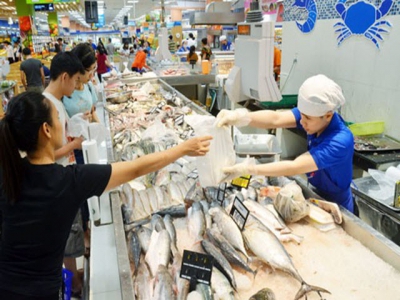Seafood exports sell poorly in domestic market

Many seafood companies’ products, which can satisfy high standards to enter the US, EU and Japan, cannot be sold in the domestic market because of technical barriers.
Seafood sells poorly in domestic market
The Vietnam Association of Seafood Exporters and Producers (VASEP) has once again sent a dispatch to the Government Office and Ministry of Health, asking the agencies to instruct the inter-ministerial steering committee on food safety to immediately promulgate MRPL (minimum required performance limit) on substances prohibited in seafood.
VASEP’s member companies want the regulation to go into effect soon, so they can plan the 2019 Tet production season.
In fact, seafood companies have repeatedly complained about this since the beginning of the year.
The problem arose when some supermarkets rejected seafood consignments containing chloramphenicol (CAP), a prohibited substance in aquaculture. The content of CAP in these products was low, below 0.3 ppb, meeting standards to be exported to the EU.
An expert explained that MRPL is the minimum requirement for testing tabs to apply. Food with a very small content of prohibited residue is safe for users.
He went on to comment that it’s funny that the products satisfying the EU’s strict standards cannot be accepted in Vietnam. This means that requirements of the Vietnamese market is even higher than the difficult-to-please EU market.
MARD has asked the inter-ministerial steering committee on food safety to assign the Ministry of Health or other ministries to compile and promulgate the regulation on MRPL with reference to the EU regulation.
According to the Ministry of Agriculture and Rural Development (MARD), the EU is the only market which sets an MRPL threshold. If the tests find the prohibited substance content in products below the MRPL, the products will still be accepted as food. In food safety management, this is just a small mistake.
MARD has asked the inter-ministerial steering committee on food safety to assign the Ministry of Health or other ministries to compile and promulgate the regulation on MRPL with reference to the EU regulation.
Nguyen Van Dao, general director of Godaco, a catfish exporter in Ben Tre province, complained that it is difficult to exploit the domestic market because of too complicated procedures.
Dao said Vietnam’s seafood processing industry now has modern production level with factories meeting the standards set by choosy markets.
He noted that foreign and domestic retailers apply different procedures to supervise the quality of products. While foreign supermarkets send staff to enterprises to examine the production process, Vietnamese supermarkets only ask to show certificates.
Meanwhile, enterprises have to follow very complicated procedures to obtain necessary certificates. It took Godaco two years to successfully bring its products to Vietnamese supermarkets for distribution.
To sell products in the domestic market, analysts say, seafood processors also have to develop the products suited to Vietnamese tastes and market conditions. In addition, they also have to spend big money on ads, which they don’t have to do with their exports.
Related news
 Vietnam moves to develop responsible fishery industry
Vietnam moves to develop responsible fishery industry Considerable efforts have been made by the entire political system, sectors and localities to fight illegal, unreported and unregulated (IUU) fishing
 Shrimp exports reach 10 billion USD
Shrimp exports reach 10 billion USD Although the market is still abundant, there is still a long way to go to reach the target of $ 10 billion shrimp exports in 2020.
 Tilapia farming under chain linkages
Tilapia farming under chain linkages Farmer Nguyễn Văn Lập owns 0.6 ha of farming ponds which produces 20% tilapias more than the previous year.